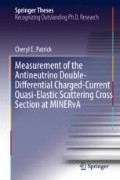Abstract
This analysis measures the charged-current quasi-elastic cross-section for anti-neutrinos incident on the plastic scintillator (CH) tracker region of the MINERvA detector. In the free-nucleon case, this interaction would be represented by: The interaction is explained in detail in Sect. 2.2. A true charged-current quasi-elastic (CCQE) antineutrino scattering interaction should produce a characteristic signature: an outgoing positive muon plus a recoil neutron. Thus, in general, our reconstruction should attempt to identify final states with this configuration, while rejecting events from other processes.
Access this chapter
Tax calculation will be finalised at checkout
Purchases are for personal use only
References
K. Abe et al., Measurement of the ν μ charged-current quasielastic cross section on carbon with the ND280 detector at T2K. Phys. Rev. D 92, 112003 (2015)
K. Abe et al., Measurement of the ν μ charged current quasielastic cross section on carbon with the T2K on-axis neutrino beam. Phys. Rev. D 91, 112002 (2015)
K. Abe et al., Measurement of double-differential muon neutrino charged-current interactions on C8H8 without pions in the final state using the T2K off-axis beam (2016). arXiv 1602.03652 (physics.hep-ex)
N. Abgrall et al., Time projection chambers for the T2K near detectors. Nucl. Instrum. Methods A 637, 25–46 (2011)
A.A. Aguilar-Arevalo et al., First measurement of the muon neutrino charged current quasielastic double differential cross section. Phys. Rev. D 81, 092005 (2010)
A.A. Aguilar-Arevalo et al., First measurement of the muon antineutrino double-differential charged-current quasielastic cross section. Phys. Rev. D 88, 032001 (2013)
C. Andreopoulos et al., The GENIE neutrino Monte Carlo generator. Nucl. Instrum. Methods Phys. Res., Sect. A 614(1), 87–104 (2010)
G. Barrand et al., GAUDI – the software architecture and framework for building LHCb data processing applications, in Proceedings, 11th International Conference on Computing in High-Energy and Nuclear Physics (CHEP 2000) (2000), pp. 92–95
M. Betancourt, MINOS tracking efficiencies for ME energy (2015). Available at http://minerva-docdb.fnal.gov:8080/cgi-bin/ShowDocument?docid=11642
R. Brun, F. Rademakers, ROOT: an object oriented data analysis framework. Nucl. Instrum. Methods A 389, 81–86 (1997)
L. Fields et al., Measurement of muon antineutrino quasielastic scattering on a hydrocarbon target at E ν ∼ 3.5 GeV. Phys. Rev. Lett. 111(2), 022501 (2013)
G.A. Fiorentini et al., Measurement of muon neutrino quasielastic scattering on a hydrocarbon target at E ν ∼ 3.5 GeV. Phys. Rev. Lett. 111(2), 022502 (2013)
MiniBooNE Collaboration, The MiniBooNE Detector. Nucl. Instrum. Methods A 599, 28–46 (2009)
J. Park et al., Measurement of neutrino flux from neutrino-electron elastic scattering (2016). arXiv:1512.07699 (physics.ins-det)
J.S. Ratchford, Identifying muons for neutrino oscillation and cross section experiments. PhD thesis, Texas U., ARL, 2012
P. Rodrigues, C. Wilkinson, K. McFarland, Constraining the GENIE model of neutrino-induced single pion production using reanalyzed bubble chamber data (2016). arXiv 1601.01888 (physics.hep-ex)
R. Subedi et al., Probing cold dense nuclear matter. Science 320(5882), 1476–1478 (2008)
T. Walton, M. Betancourt et al., Measurement of muon plus proton final states in ν μ interactions on hydrocarbon at \(\left <\mathrm {E}_\nu \right > =4.2\mathrm {GeV}\). Phys. Rev. D 91, 071301 (2015)
Author information
Authors and Affiliations
Rights and permissions
Copyright information
© 2018 Springer International Publishing AG
About this chapter
Cite this chapter
Patrick, C.E. (2018). Charged-Current Quasi-Elastic Event Selection. In: Measurement of the Antineutrino Double-Differential Charged-Current Quasi-Elastic Scattering Cross Section at MINERvA. Springer Theses. Springer, Cham. https://doi.org/10.1007/978-3-319-69087-2_4
Download citation
DOI: https://doi.org/10.1007/978-3-319-69087-2_4
Published:
Publisher Name: Springer, Cham
Print ISBN: 978-3-319-69086-5
Online ISBN: 978-3-319-69087-2
eBook Packages: Physics and AstronomyPhysics and Astronomy (R0)

